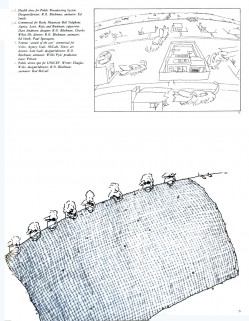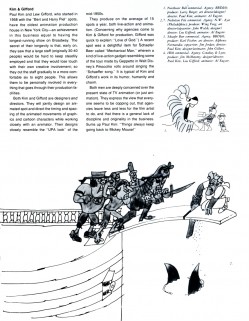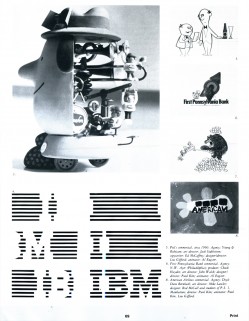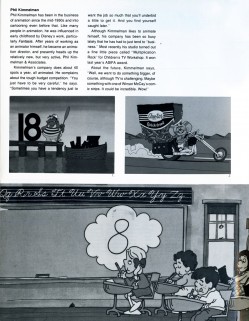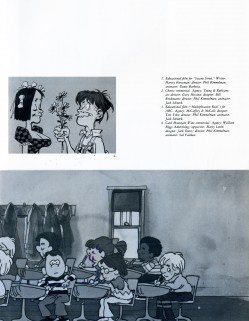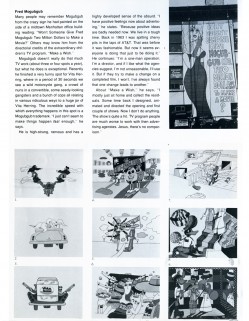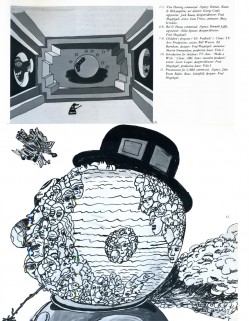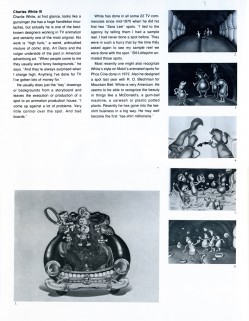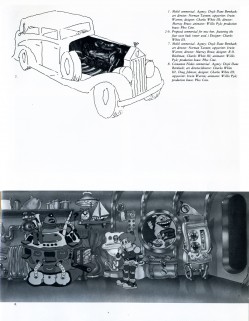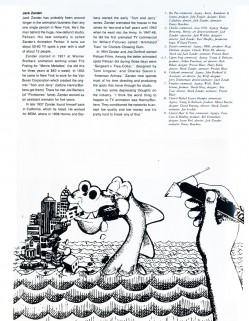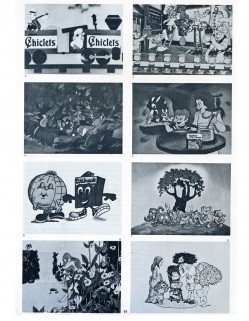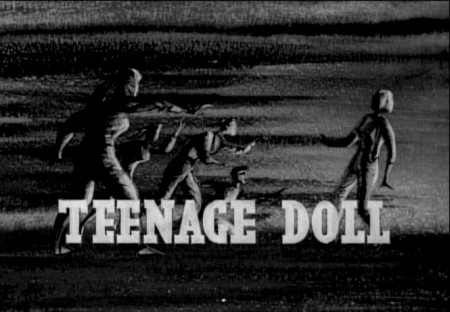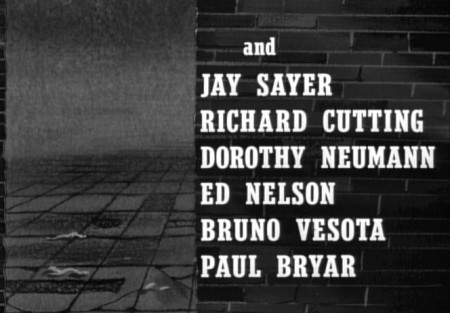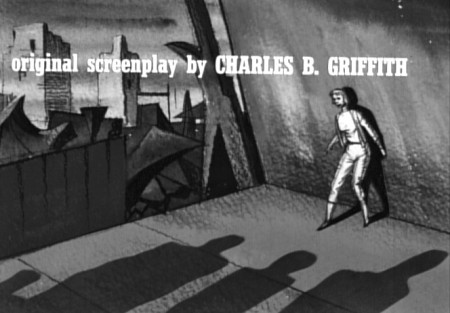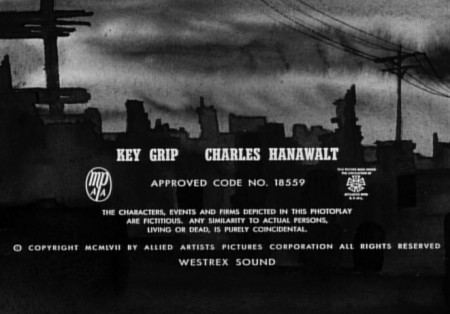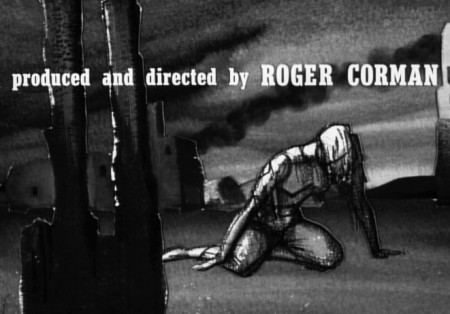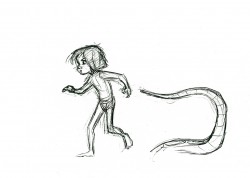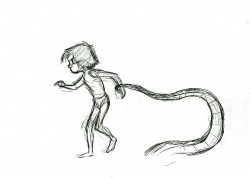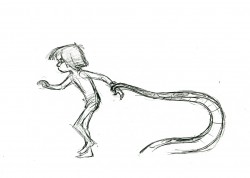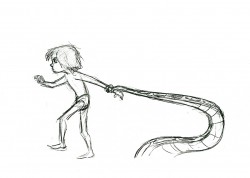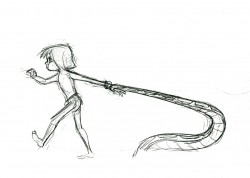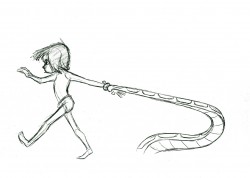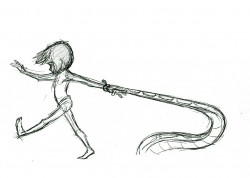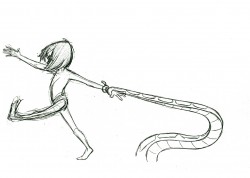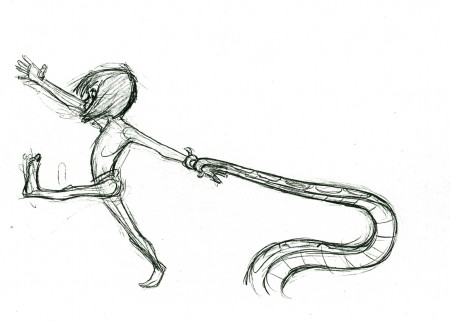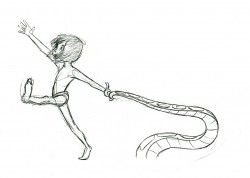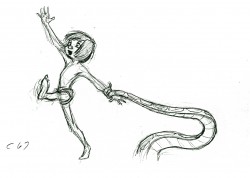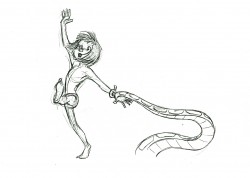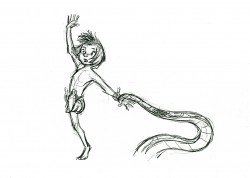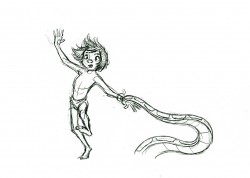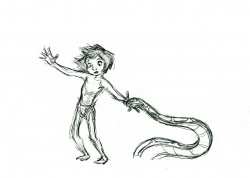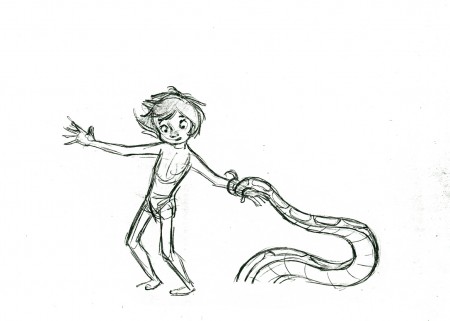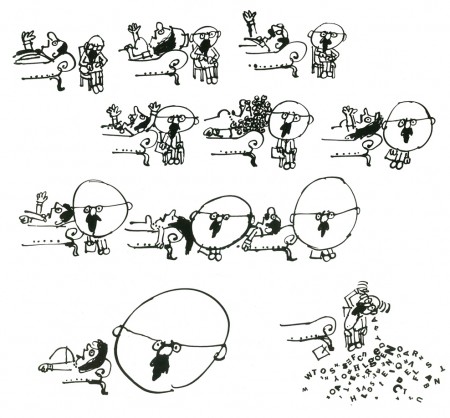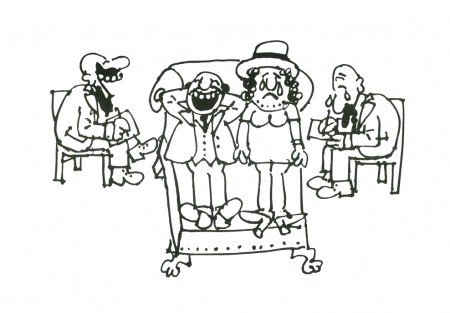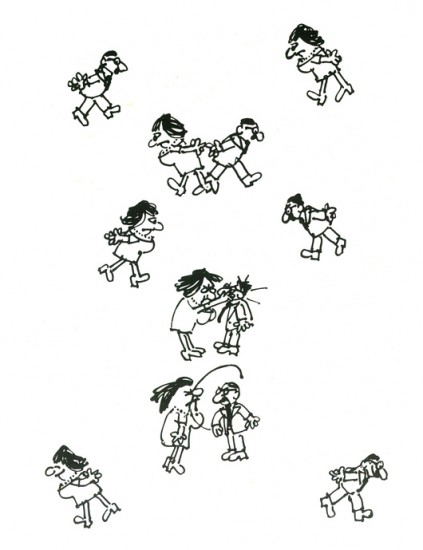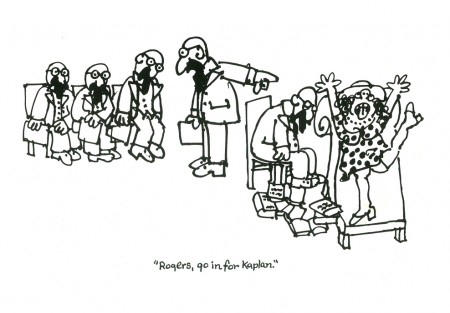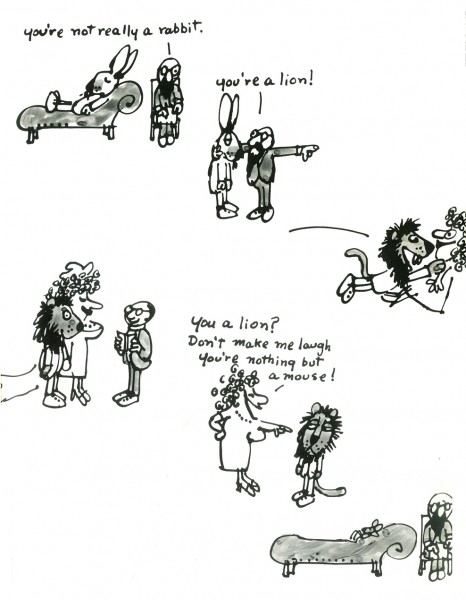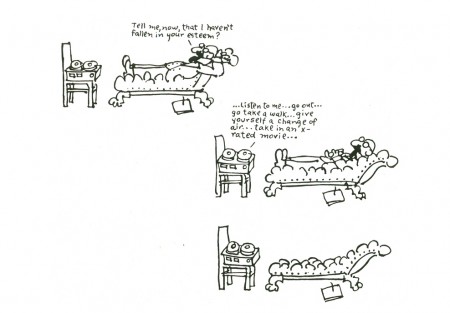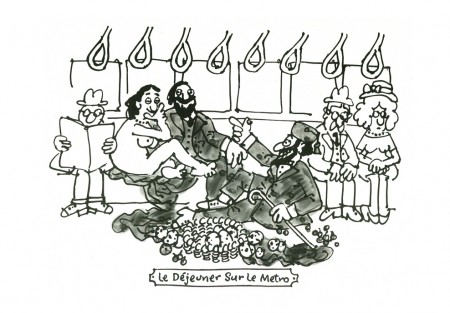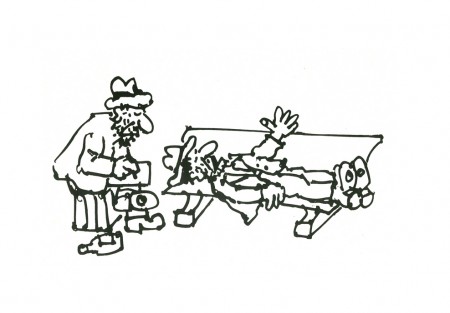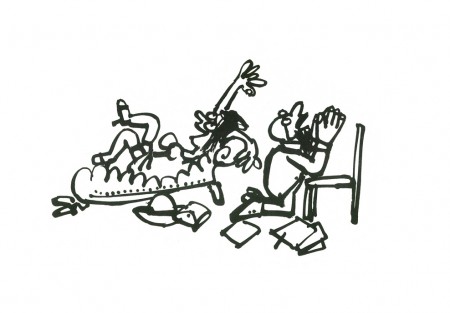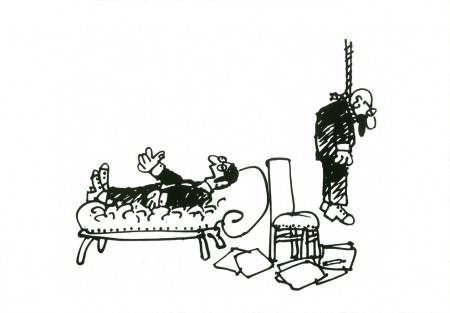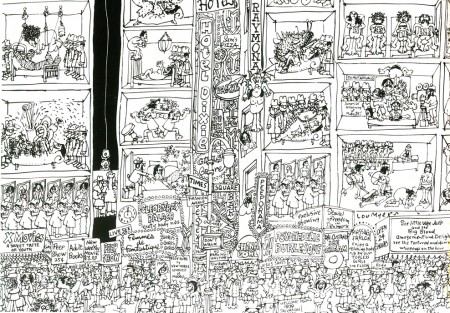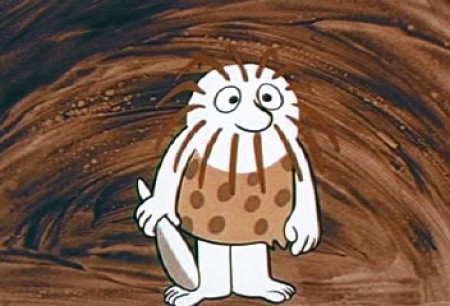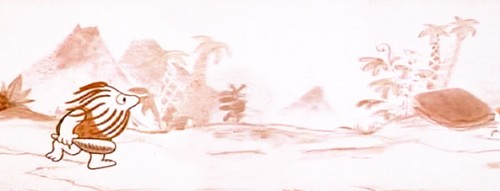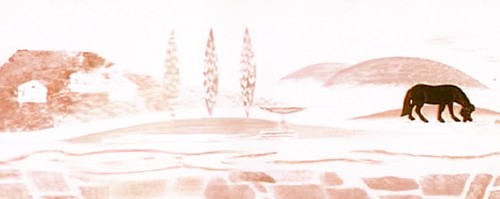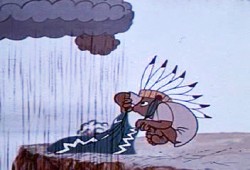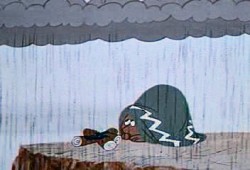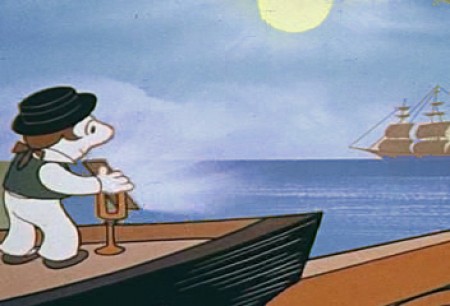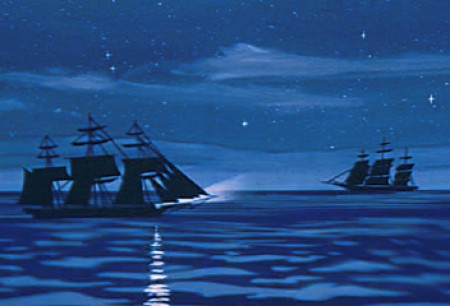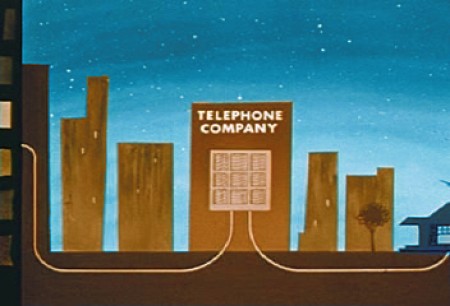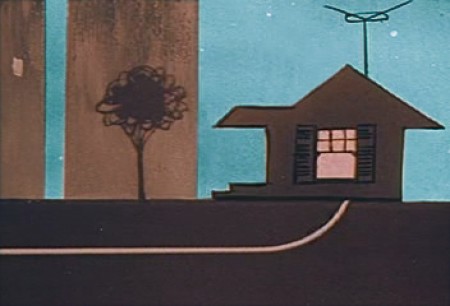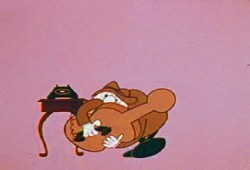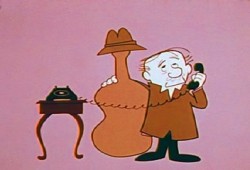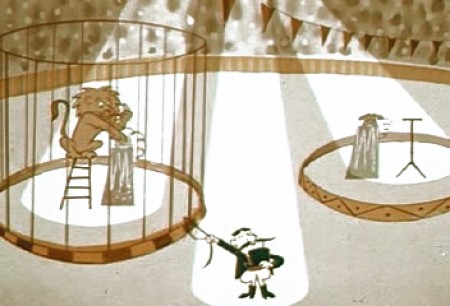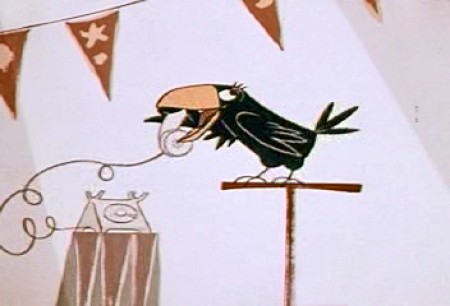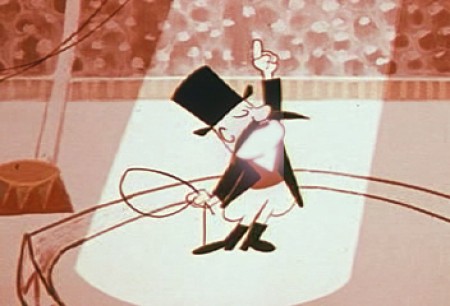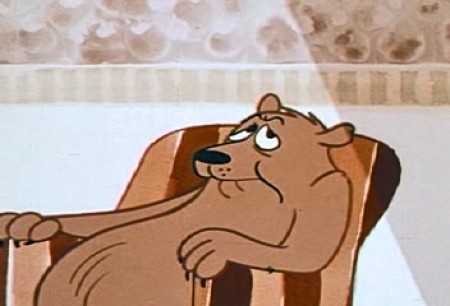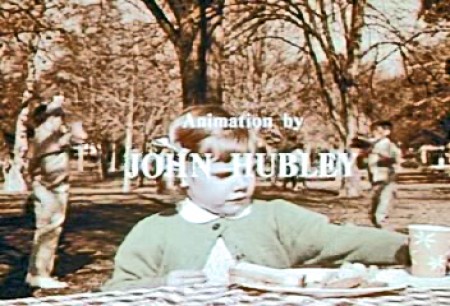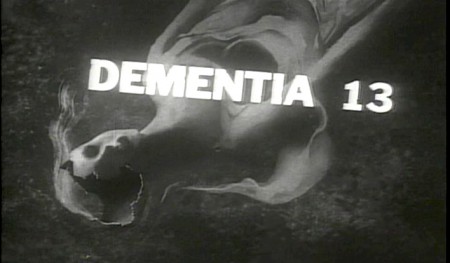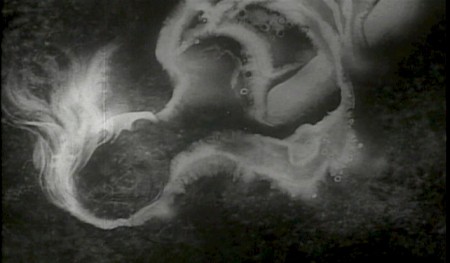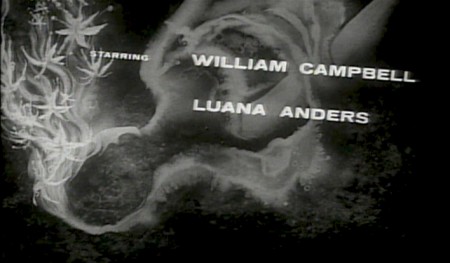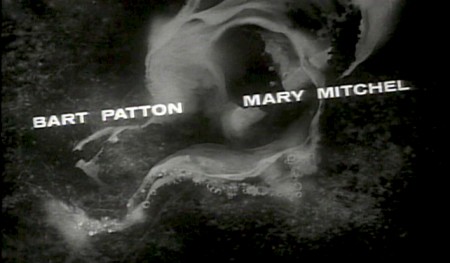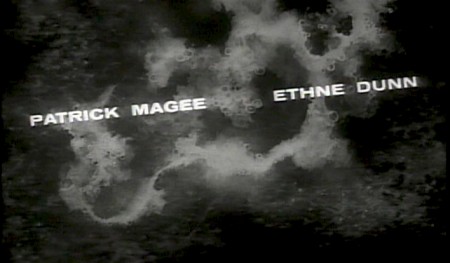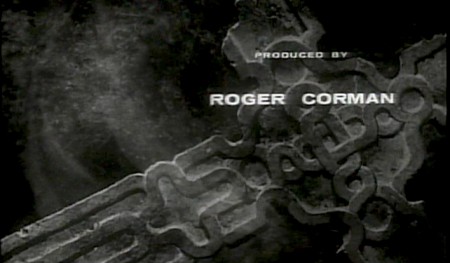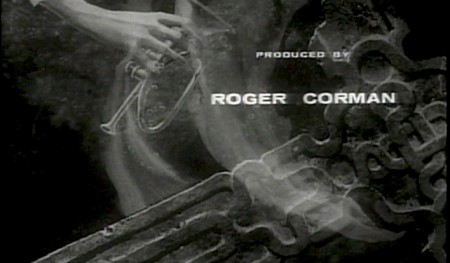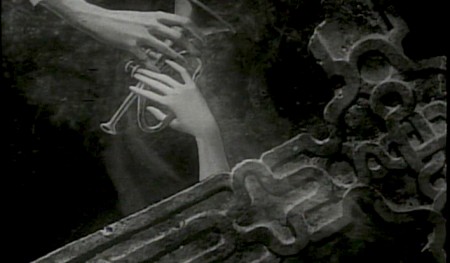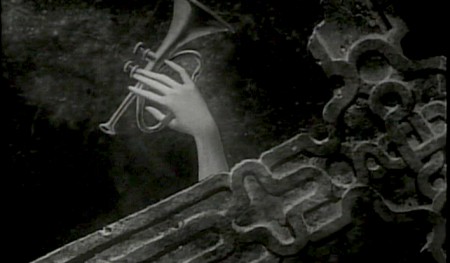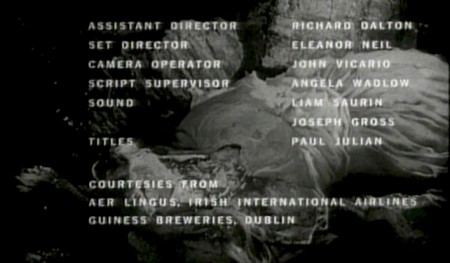Yearly Archive2009
Animation &Independent Animation 22 Oct 2009 07:53 am
Pups of Liberty – Interview
- I’m an Independent Director/Animator/Producer of animated films. As such I watch closely what else is going on independently in the world of animation. I try to keep up with most of the short films made and being made; I try to keep up with all the people involved in that world.
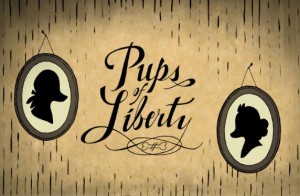 In the old days, one had to go to the Festivals around the world to see these films. ASIFA East often brought some of these films and filmmakers to our local meetings, but generally you had to travel to see the average film. The big, famous award winners would always show up somewhere. Nowadays, the Internet has brought more films and artists into my life, and I get to see more of the less than sterling flms from around the world. Ian Lumsden’s Animation Blog has introduced me to many films I wouldn’t have even known to look for including many gems. Niffiwan‘s Animatsiya in English brings Russian films that would otherwise escape my notice. There’s a lot out there, and I keep looking.
In the old days, one had to go to the Festivals around the world to see these films. ASIFA East often brought some of these films and filmmakers to our local meetings, but generally you had to travel to see the average film. The big, famous award winners would always show up somewhere. Nowadays, the Internet has brought more films and artists into my life, and I get to see more of the less than sterling flms from around the world. Ian Lumsden’s Animation Blog has introduced me to many films I wouldn’t have even known to look for including many gems. Niffiwan‘s Animatsiya in English brings Russian films that would otherwise escape my notice. There’s a lot out there, and I keep looking.
The fortune of having a modestly successful blog is that some filmmakers actually approach me. Such was the case with Jennifer & Bert Klein‘s Pups of Liberty. They sent me a link to their site which offered a trailer for their short film, and they offered to send me a DVD of the entire film.
When I looked at their site and trailer, it was obvious this wasn’t your average short. I saw the very full animation, beautiful backgrounds, and I looked deeper.
I saw the credit list and the names of James Lopez (Animator on Hercules, Emperor’s New Groove, Flushed Away and Princess and the Frog), Eric Goldberg (Animator on Aladdin, Fantasia 2000, and Princess and the Frog), Barry Atkinson (BG artist on Prince of Egypt, American Tail and The Lion King), and Mark Henn (Animator Ariel, Belle, Jasmine, Mulan and Tiana) among others. I had to see this film.
I wasn’t disappointed. The animation is sterling in the richest of full animation; the Bg’s are beautifully styled to feel like the period (the Revolutionary War) they’re meant to suggest, and the Direction couldn’t be cleaner or clearer or more focused. The film doesn’t waste a shot, but drives itself through the story in a very economical approach. Yet not a dollar seems to have been spared in making this the extraordinarily lush film it is.
I had to respond to Jennifer and Bert Klein to ask for a short interview and they responded with answers to any question I posed and plenty of supportive material. Hence, I’ll post that Q&A today with some stills from the film, and tomorrow some amazingly attractive pre-production artwork. This film deserves a book of its own.
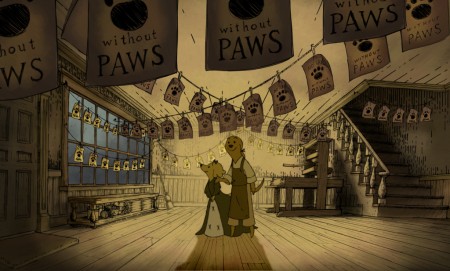
All images copyright © 2009 Picnic Productions
The Interview
Michael – What prompted you to develop this story? It reminds me a bit of Disney’s Johnny Tremaine in the way that it focuses on a particular craftsman and his daughter, just as the live action film focused on a silversmith and his apprentice. Was there any inspiration from that film/book? Animation wise, it feels a bit like Ben & Me. Perhaps that’s because of the subject.
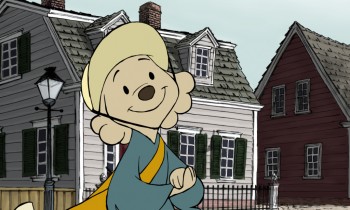 Jennifer – I have always loved this era of history (Colonial/Revolutionary America) so when I first began developing an idea for a new short it was the first setting that came to my mind. I wanted to make a story that was quality and that a viewer would feel good about watching; I was also very interested in how to teach people concepts (like taxation and representative government) with a media like animation.
Jennifer – I have always loved this era of history (Colonial/Revolutionary America) so when I first began developing an idea for a new short it was the first setting that came to my mind. I wanted to make a story that was quality and that a viewer would feel good about watching; I was also very interested in how to teach people concepts (like taxation and representative government) with a media like animation.
The story of the Boston Tea Party seemed like an iconic event to start with, since most American school kids learn about it pretty early on. The more I researched the more I was drawn to the story of the printer who started the Sons of Liberty. I love the idea of a group of ordinary people getting together to motivate change in their world, and I liked that that is something that translates internationally, to everyone.
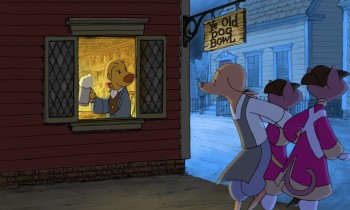 I grew up watching Robin Hood because it was the only Disney movie we had. At some point I saw Ben and Me and I have always liked that one a lot too. I like allegorical story telling, fables… so it seemed natural to tell the story with animals. In a way it lightens up the mood of it having a political bent- because really, they are talking dogs and cats.
I grew up watching Robin Hood because it was the only Disney movie we had. At some point I saw Ben and Me and I have always liked that one a lot too. I like allegorical story telling, fables… so it seemed natural to tell the story with animals. In a way it lightens up the mood of it having a political bent- because really, they are talking dogs and cats.
Bert – We initially considered making a film about the first Thanksgiving with cats as pilgrims and birds as the native Americans. We moved ahead in time a bit and did the Boston Tea Party instead.
I’m sure you don’t want to discuss your budget, but you must have gotten a lot of incredibly talented people to volunteer to help you make the film. (Eric Goldberg, Mark Henn et al). The expense easily looks quite high.
Michael - Was the budget completely out of pocket?
- How did you create such enthusiasm for the project to do so?
- Now that you’ve finished what is your hope for distribution or future development?
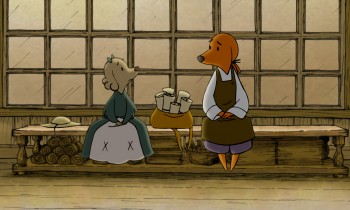 Jennifer – Our budget was all out of our own pocket. We might be a little crazy I guess, but this is what we do. It’s our hobby. Bert and I are very passionate about making shorts, and when we began the project we were also very interested in keeping ourselves in practice for 2d animation at a time when there weren’t any other 2d features being made at any of the studios. Our friends who worked traditionally started to hear about the film and we would have evenings with everyone over and do pencil tests and see them cut into the storyreel – and we’d always have pie, I would bake every night for the crew. The nights started to take on a family atmosphere, and I think everyone felt very comfortable to come and practice their art that they had been trained to do. Everyone was working at their highest skill level– Mark Henn was doing 20 feet a week, James Lopez stretched himself and all of our layouts, we had cleanup people doing the most beautiful work I had ever seen from them. I can’t say how we “created” enthusiasm because you can’t consciously create something like this. You’re just darned lucky that it happens.
Jennifer – Our budget was all out of our own pocket. We might be a little crazy I guess, but this is what we do. It’s our hobby. Bert and I are very passionate about making shorts, and when we began the project we were also very interested in keeping ourselves in practice for 2d animation at a time when there weren’t any other 2d features being made at any of the studios. Our friends who worked traditionally started to hear about the film and we would have evenings with everyone over and do pencil tests and see them cut into the storyreel – and we’d always have pie, I would bake every night for the crew. The nights started to take on a family atmosphere, and I think everyone felt very comfortable to come and practice their art that they had been trained to do. Everyone was working at their highest skill level– Mark Henn was doing 20 feet a week, James Lopez stretched himself and all of our layouts, we had cleanup people doing the most beautiful work I had ever seen from them. I can’t say how we “created” enthusiasm because you can’t consciously create something like this. You’re just darned lucky that it happens.
We are submitting the Pups to film festivals, so we will have about 2 years worth of that, and then we’ll see what happens. My biggest hope would be for a series. I would also love to see it in the classroom one day.
Michael – It must have taken quite some time since I doubt you were able to work steadily on the film and had to fit it in between other jobs. (I’ve seen your resume and know you’ve been busy outside of this film.)
- How long did it take to make, given your work schedule?
- How were you able to maintain such a consistent (and consistently high level) look while working on it on a long, piecemeal schedule? (Assuming that was the case?)
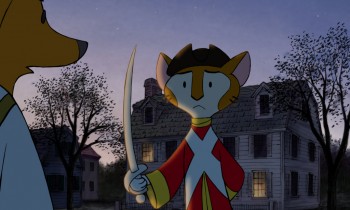 Bert – Most of the production took place during spare time over a two year period. The births of our two kids stretched out the last bits almost another two years.
Bert – Most of the production took place during spare time over a two year period. The births of our two kids stretched out the last bits almost another two years.
One way we ensured consistency was having Jennifer do clean up keys over the different animators’ drawings to maintain the style. Mark Henn did a lot of animation on the film and helped raise the bar for everyone else. One person (James Lopez who was a supervising animator at Disney for a decade) did all of the layouts. I animated a lot of it myself and just kept working on it until it was done. Our assistant director Hyun-Min Lee was invaluable to us in getting this done, tackling technical problems, organizing scenes and x-sheets, and trackreading amongst many other jobs.
Jennifer – I took some time off to work on the film, so I was able to dedicate all of my time to it. I did the boards, designed the characters, did reds for the cleanup keys. I think that the simplicity of the characters saved us a lot of line mileage and made it possible for the artists to get through the footage quickly. They also look best against the backgrounds, which are done in a hand drawn pen-and-ink style and required something simple to contrast with them. We looked at the printwork from the time for inspiration- Paul Revere’s engravings especially really had a ‘homemade’ colonial feel, and you can see his personality in them and in the brush strokes of color used that we tried to invoke.
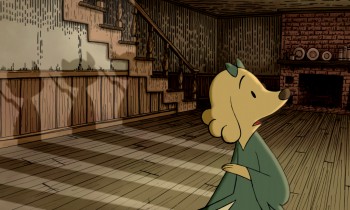 It is hard to sit down and work after you have worked a full day, but I always remembered something Bert would say- “Even if you just get one drawing done you are one drawing ahead.” So I’d try and get one scene’s worth of layouts done a night, or read a track, or just something, and we’d inch forward until we were done.
It is hard to sit down and work after you have worked a full day, but I always remembered something Bert would say- “Even if you just get one drawing done you are one drawing ahead.” So I’d try and get one scene’s worth of layouts done a night, or read a track, or just something, and we’d inch forward until we were done.
Michael – Just as American Tail was compared to MAUS, your film has already received a comment on Cartoon Brew comparing it. There are very obvious differences, but I wonder if you thought about this possibility?
- Or worried about it?
- Did you ever question the idea of doing it with humans?
- Or would that have made you focus even more on historical accuracy?
Bert – I heard of MAUS, but I’ve never read it. Our main reason to make this was purely a labor of love. I watched Jennifer do great work as a story artist on lots of feature projects for studios that never got made or changed radically from the first inception. She was one of the original story artists on Where the Wild Things Are when it was a fully animated feature back in 2001. I wanted to produce a film that was a showcase for her story sensibilities because I felt that it might be the only way to get that pure vision to the screen. We also hope that people and their kids can enjoy it.
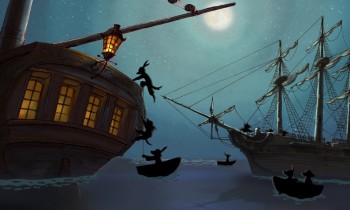 Jennifer – Honestly I never heard of Maus. Whatever subject matter you make a film about though, there will always be something to compare it to — how many films are there about aliens? Or zoo animals? A setting is just a setting- it’s how you hook the audience in, how you make them really feel for and believe in your characters, and the experience that you give them that matters.
Jennifer – Honestly I never heard of Maus. Whatever subject matter you make a film about though, there will always be something to compare it to — how many films are there about aliens? Or zoo animals? A setting is just a setting- it’s how you hook the audience in, how you make them really feel for and believe in your characters, and the experience that you give them that matters.
Doing a historical film with humans instantly makes it more serious- doing it with animals, you can’t take it as seriously and you can have more fun with it. Why animate humans when you can animate talking dogs? It made us laugh. We did it this way so that we could have some fun, and do what we love to do.
Articles on Animation &Bill Peckmann &Daily post 21 Oct 2009 08:19 am
Print ’74
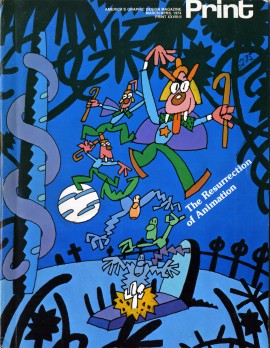 - I seem to remember a lot of industry magazines that would regularly publish articles about the animation industry. Millimeter, Film Comment, On Location, Hollywood Reporter all had their animation issues that I’d search out (long before I entered the business professionally), pore over, memorize and save.
- I seem to remember a lot of industry magazines that would regularly publish articles about the animation industry. Millimeter, Film Comment, On Location, Hollywood Reporter all had their animation issues that I’d search out (long before I entered the business professionally), pore over, memorize and save.
Print Magazine was a glossy magazine that featured lots of articles about design, usually print design, although there was the occasional animtion article. In 1974, there was a big issue about animation. One article, by Rod McCall, who was a designer for print as well as film, wrote an article about the commercial studios in New York with an accent on the design aspect.
Here’s that article, which is picture-centric in jpegs. If there were more text I’d have transcribed it, but this format seems best since the article is so attractively designed within the magazine.
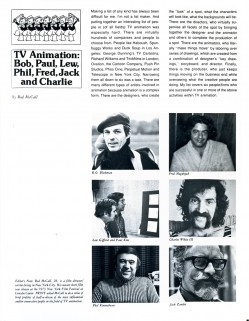 1
1 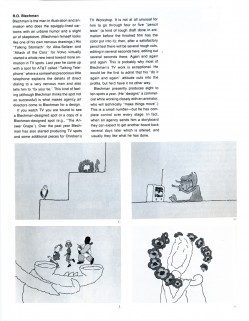 2
2(Click any image to enlarge and read.)
Thanks to Bill Peckmann for the magazine to scan and share.
Commentary &Illustration 20 Oct 2009 07:48 am
Not Paul Julian’s Wild Teen
- Here are the scenic art that makes up the title sequence to Roger Corman’s film, Teenage Doll. I would be posting this as a Paul Julian title, as many ardent fans credit the titles. But they’re wrong, this is not the work of Julian. It’s a poor imitation.
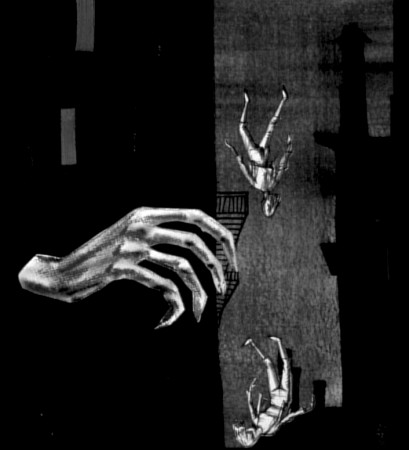
(Click any image to enlarge.)
A couple of peculiar cards set up the main title.
First a very slow pan down while hands appear and disappear.
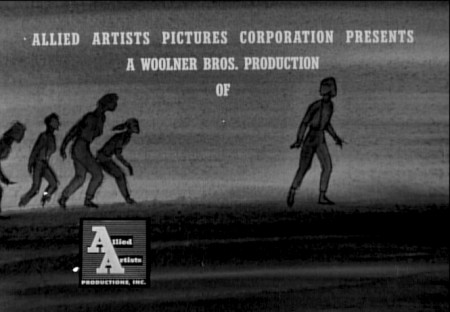
Allied Artists gets their title card – not full screen!

The camera pans across brick wall fragments
as a few names come and go.
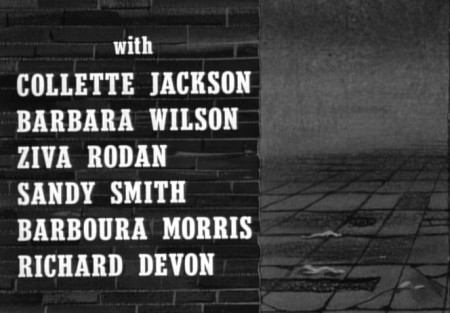
The camera makes a slight move as we go from the
title above to the title below.
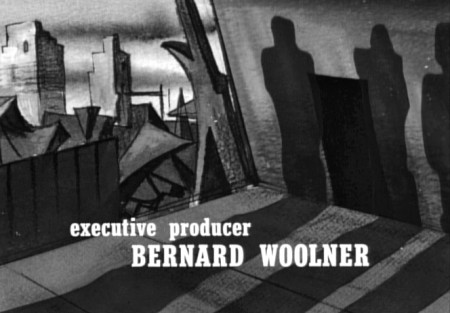
Shadows move in as type changes.

Cut to a pan as a bunch of titles fade on and off.
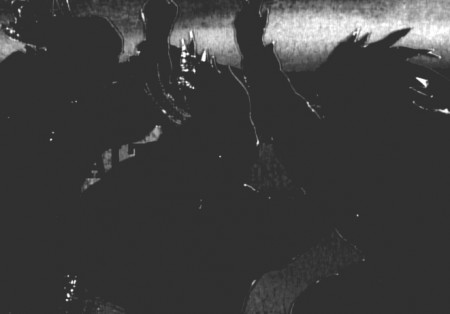
Some black cut out figures pan up and in.
They’re so shoddily produced that the lights are
shining off the edges of the card.
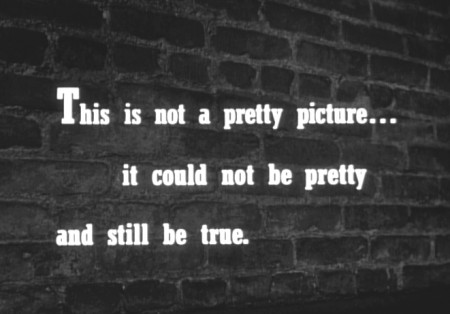
The text is printed over a photo of a brick wall.
I guess they had no left over artwork.
Obviously there are problems with this title sequence. The worst has to be seen as it moves on screen. A pathetic sense of timing has type popping on and off the screen too brieftly or held too long. The artwork looks more like some agency storyboard than actual production artwork.
This is most certainly not Paul Julian’s work. Stylistically it’s obvious, however, there’s so little professional about these titles that I know Julian couldn’t have been involved.
What I expect happened, was that he was offered the job for less than the couple of hundred dollars usually offered. He turned it down and some beginner took it to get his feet wet. Too bad.
The unfortunate part is that the designer didn’t even get a credit, so we don’t know who did it.
Animation &Animation Artifacts &Disney 19 Oct 2009 07:37 am
Frank Thomas’ Jungle Book 3
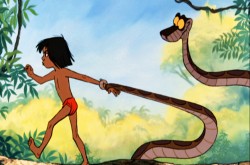 - This is the last of three posts showcasing the drawings of Frank Thomas for one scene of Mowgli and Kaa in The Jungle Book.
- This is the last of three posts showcasing the drawings of Frank Thomas for one scene of Mowgli and Kaa in The Jungle Book.
Frank was a very productive animator who was very defensive of his drawing ability, yet he always seemed to come up with something attractive and full of his gentle personality.
There is some nice use of foreshortening in the leg of Mowgli in these drawings. You have to be particularly good at drawing to make it work; I think I’ve seen too many bad drawings where it’s called attention to itself. Foreshortening is usually something worth avoiding unless you feel really confident about it. However, as done by Frank, it really helps the motion.
Again there is a smart use of ones and twos, and there seems to be no effort in having moved back and forth between the two. Yet, when you look at the movement, it seems natural.
The scene also ends in the middle of an action, something an editor might do, but it seems to be controlled by the animator here.
The entire scene is now up in all of the QT’s posted.
Part 1
Part 2
We start with the last drawing from Part 2.
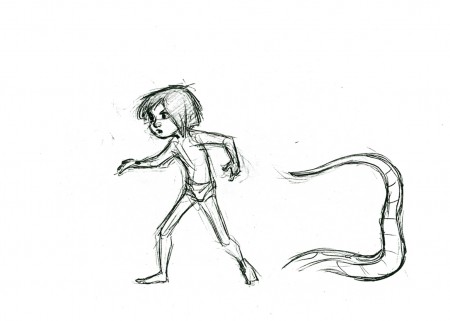 51
51(Click any image to enlarge to full animation sheet size.)
The QT movie below includes Parta 1, 2 &3 of this scene.
Mowgli & KaaClick left side of the black bar to play.
Right side to watch single frame.
Many thanks to John Canemaker for sharing these drawings with us.
Books &Photos 18 Oct 2009 08:12 am
Art Director Awards ’57
- I enjoy thumbing through the Art Director’s Annuals. There’s a lot of amazing illustration to view with plenty of ideas and sharp graphics on display. I have, as a good example of these hard-covered catalogues, the 1957 issue. 90% of the book is composed of illustration in the different advertising fields. A small section is devoted to TV spots and illustration. Naturally, I have a strong interest in this section.
Editorial Art, Advertising Art and Television Art all get their chapters.
Here is a pictoral list of the winners in animation for the TV commercials awards in 1957. A number of these spots have remained familiar (at least as images in old animation books – like Halas’ Technique of Film Animation.)
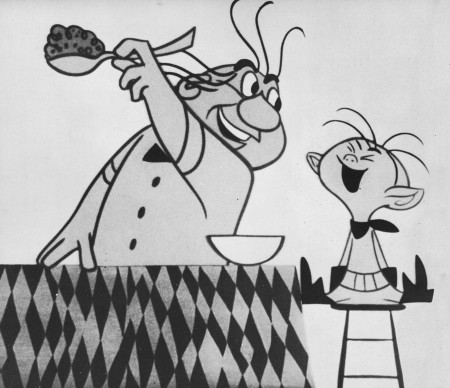
The biggest prize went to John Hubley’s Maypo commercial.
Storyboard Inc. – producer
John Hubley – Director & Art Director
Emery Hawkins – animator
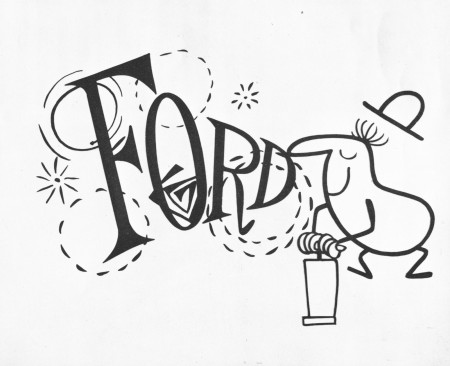
Ford commercial
Playhouse Pictures – producer
Bill Melendez – director
Sterling Sturtevant – Art Director
Bill Littlejohn – animator
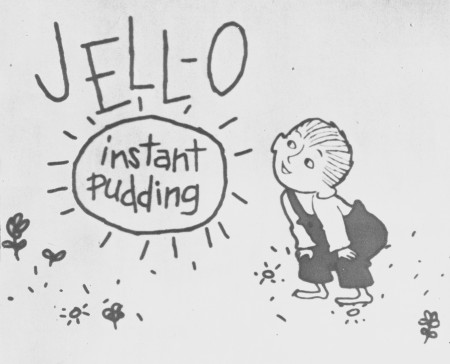
Jello
Ray Patin Productions – producer
Sonia Linker – Art Director
Maurice Sendak – artist
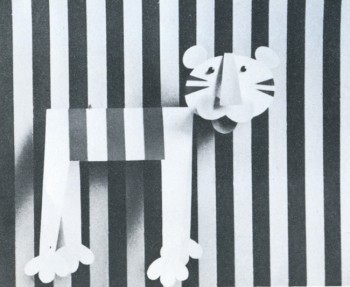
Maxwell House
Audio Productions Inc. – producer
Jerome Kuhl – artist
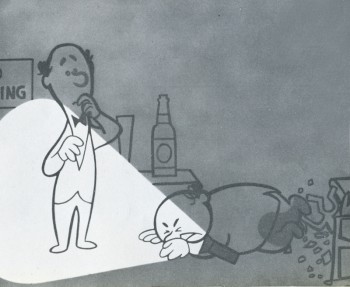
Piels Brothers Beer
UPA – producer
Jack Sidebotham – art director
Chris Ishii – designer
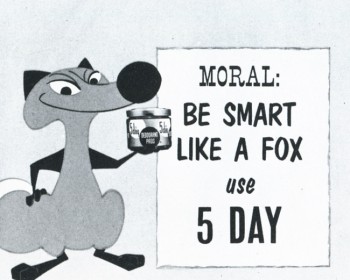
5 Day Deoderant
Storyboard Inc – producer
John Hubley – art director
Art Babbitt – animator
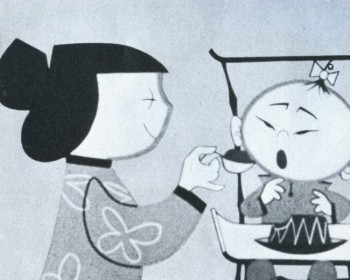
Jello Baby
Ray Patin Productions – producer
Ruchard Vab Benthem – artist
Ken Champin – photographer
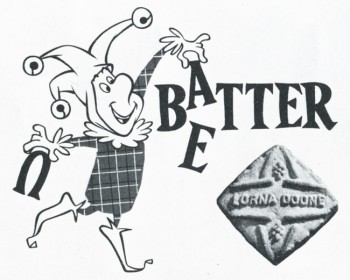
Lorna Doone
Bill Sturm Studio
Frank Broadhurst – art director
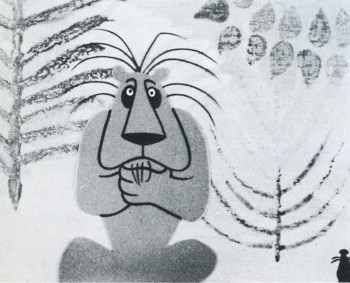
The Lion and the Mouse – Prudential
Storyboard Inc. – producer
John Hubley – director
Art Babbitt & Emery Hawkins – animation
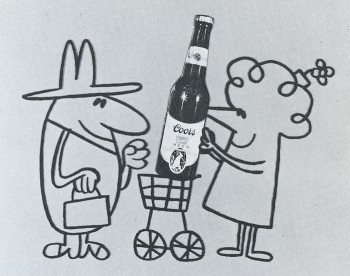
Coors Beer
UPA – producer
Jules Engel – director
Fred Crippen – art director
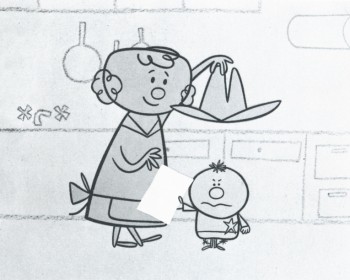
Scott Paper Co.
UPA – producer
Jack Goodford – art director
Grim Natwick, Sam Wiggenhorn – animators
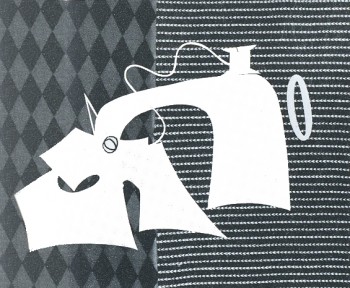
Donahue Sales Corp.
UPA – producer
Jack Goodford, Chris Ishii – art directors
Cliff Roberts – animator
Books &Comic Art 17 Oct 2009 09:09 am
Lou Myers
- I’ve been a fan of the panel cartoonist, Lou Myers, for ever. His work makes me laugh. His drawing style looks like art to me, and that makes me laugh, too. He has a numbner of books on the market that collect his cartoons.
His book, Absent & Accounted For, is a good sampling of his work. I pulled it off my shelf last week and it got me laughing. So I thought I’d give you a few of the cartoons in the book. It’s a gem, published in 1980. Lots of therapists and sex jokes. Here are some of the therapy gags.
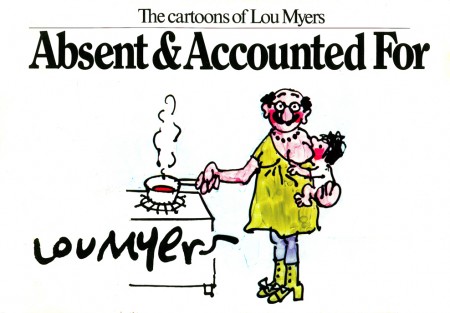
(Click any image to enlarge.)
Some of Lou Myers other books include:
When Life Falls It Falls Upside Down, Christmas Favorites, Ha Ha Ha Hyenas, and Tutti Frutti.
Commentary &Daily post 16 Oct 2009 08:15 am
Ranting/USC/Free Lancing/Updates/Rain!
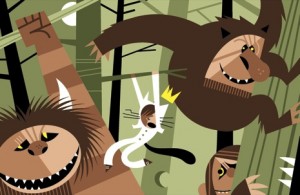 - Last night I saw Where the Wild Things Are. To be honest, I didn’t really want to go, but went just the same. Not good.
- Last night I saw Where the Wild Things Are. To be honest, I didn’t really want to go, but went just the same. Not good.
Yes, I know all the reviews I’ve seen are glowing. But I found it boring once they settled in on the island.
David Denby‘s review in the New Yorker got it right. Read it before you go; that’s the film you’ll see.
The cgi manipulated faces of the characters is excellent as are the voices. Sensational acting by James Gandolfini, Lauren Ambrose, Catherine O’Hara, Chris Cooper, Paul Dano and Forest Whitaker. All of them. And the kid, he’s good, too.
But Spike Jonze! Why do you have to tell us everything that’s going on on screen? Why do you have to overanalyze a book that has so much depth; it gives us reason to think. Do you just want to stop us from thinking? Give me the book. I don’t want this thing to sit in the unconscious memory of children watching. Give them the book. Yccch!
It’s an adult’s idea of adapting a children’s book. Repetitive, Tiresome and Boring.
___________________

- I’d be afraid to see the Jim Carrey Christmas Carol soon to come out. From the look of it, they’re throwing everything and the kitchen sink at the audience through the magic of 3D. Christmas wreaths, icicles, snow, even Jim Carrey. They all fly in our face. $5 extra, please, for the glasses and $3 extra for the aspirins to take care of the headache.
- According to a piece in The Wrap, Wes Anderson didn’t want to stay on set during the tedious two year shoot of The Fantastic Mr. Fox, so he went to Paris while the film’s “Director of Animation”, Mark Gustafson, did the heavy lifting. Footage was sent via email to Paris and back a response would come.
Anderson said, “the movie would not be the way I wanted it if I just did it the way people were accustomed to doing it.†Give that man an Oscar.
- Tomorrow at USC, the Entertainment Law and Business Conference will be held. Described as “…in-depth examinations of the newest opportunities in animation.”
Guest panelists will include:
- Robert A. Iger, president and CEO of The Walt Disney Company who will be the keynote lunchtime speaker.
The heads of four major talent agencies: Jeffrey Berg (ICM), Jim Berkus (UTA), Ari Emanuel (WME) and David O’Connor (CAA). They will participate in discussion on “The Future of Agencies.”
Tom Sito will talk on animation’s future and how it will depend on continued technical development or a refocus on storytelling and character? And what opportunities exist for creators of new media, such as animated webisodes or short-form flash animation on the Web?
Saturday, Oct. 17. The session on “New Opportunities for Animation” will begin at 9 a.m. The doors open for registration at 7:30 a.m.
For more info call USC Law’s Continuing Legal Education office at 213-743-1772 or log on to their site.
- A friend, Steve Parton sent this YouTube video about the fun of freelancing as a designer – though it’s applicable to anyone who works in this business. It’s a laugh, if you haven’t seen it as yet.
___________________
- RIchard O’Connor has been giving daily updates on the Ottawa Animation Festival, as it progresses. There’ve been two posts, to date, and if you have any interest in what’s up at this Festival, you owe it to yourself to check it out. Asterisk Animation
Day #1
Day #2
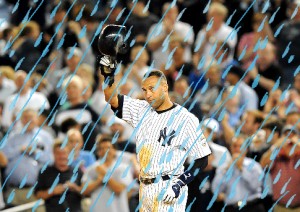
- The rain that left LA, earlier this week, has made it to New York and will dampen (if not deluge) our weekend in the City. (Thanks, LA.)
I wouldn’t mind, but I’m waiting somewhat impatiently to see the Yankee-Angels games, and I hope they won’t be rained-out. I have too much emotional investment in that series to be blottoed by RAIN!
Hubley 15 Oct 2009 07:38 am
We Learn About the Telephone
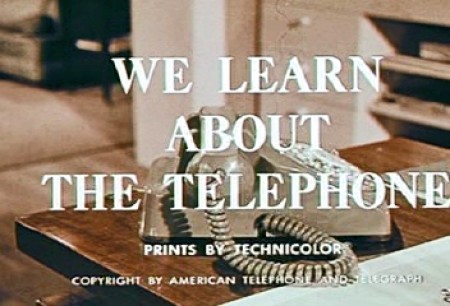 – In 1965, John Hubley directed animation inserts for an educational film for Jerry Fairbanks Productions and AT&T. It’s the story of the history of the telephone and how it works. The story, such that it is, tells about two kids visiting their uncle, an animator (actually, an actor playing an animator). He gives them an animated lecture on the story of the phone.
– In 1965, John Hubley directed animation inserts for an educational film for Jerry Fairbanks Productions and AT&T. It’s the story of the history of the telephone and how it works. The story, such that it is, tells about two kids visiting their uncle, an animator (actually, an actor playing an animator). He gives them an animated lecture on the story of the phone.
The film reminds me very much of another film done by the Hubley studio. UPKEEP was the history of the IBM repairman. We travel through history to see how the repairman has worked over the years. It’s a successful device that works in John’s hands.
The film is available to view on the Prelinger Film Archives. I’ve made some frame grabs to post to give an idea of the style. The characters seem to shift a bit stylistically from the humans at the beginning to those later at the circus. From Hubley to Jay Ward. This was a period where John Hubley was beginning to experiment with more expeditious styles for the jobs that came in. The more artful Maypo style was a bit complicated to pull off. The cels, here, are cel-painted traditionally. (I actually have a hard time believing the date on this film – 1965. It feels more like late 50′s.)
The backgrounds are all by John Hubley, and they remind me of those he would do for UPKEEP and PEOPLE PEOPLE PEOPLE. Lots of white space and soft images. The animation looks like it was done by several people. I recognize Emery Hawkins‘ style, and I also can see Bill Littlejohn in there.
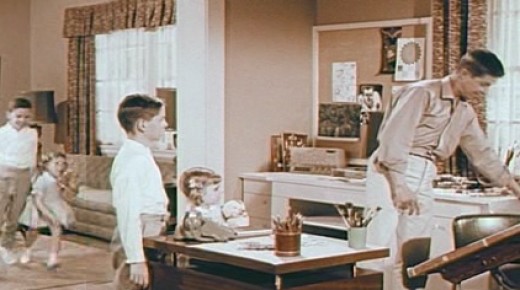 1
1The animator’s studio.
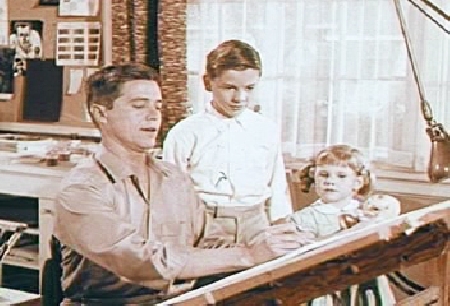 2
2
Kids are always fascinated when an animator draws.
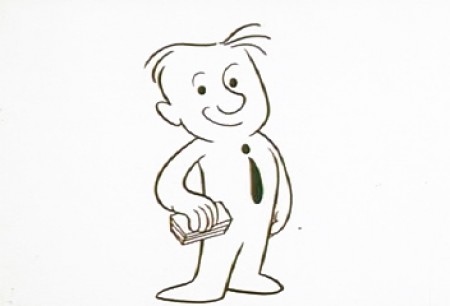 3
3
The character goes from this . . .
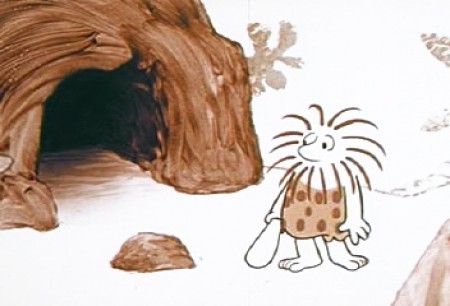 5
5
The caveman has to deliver a message.
![]()
This is the full length of his run, the pan wherein the character
runs from being a caveman to an Egyptian to a Roman.
Here’s the same BG broken into four parts:
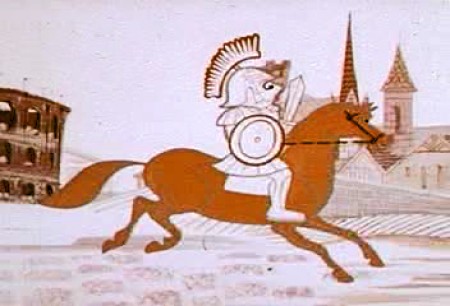 6
6
Once on horseback, man travels through
the middle ages to the pony express.
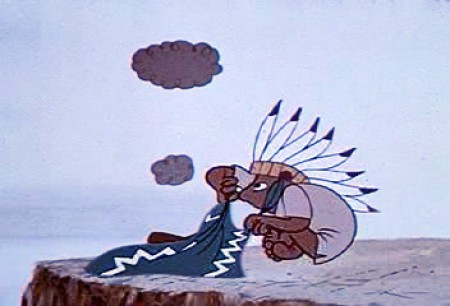 7
7
Man turns to smoke signals to communicate.
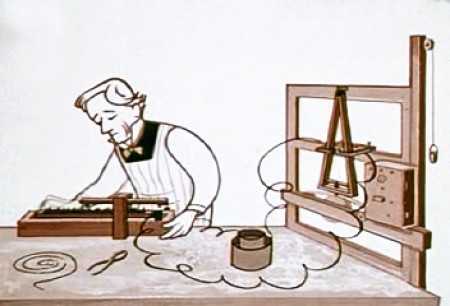 11
11
Morse invents the telegraph.
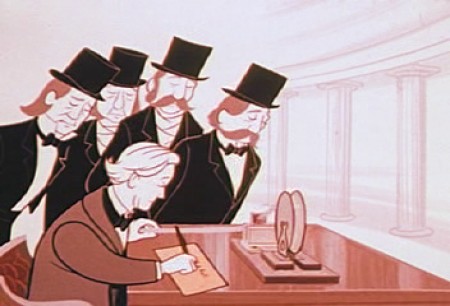 12
12
Alexander Graham Bell invents the telephone.
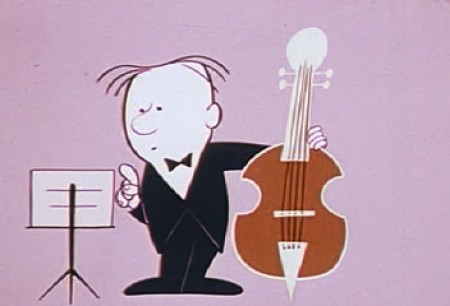 13
13
Now the animator explains how the telephone works
to two very interested children. .
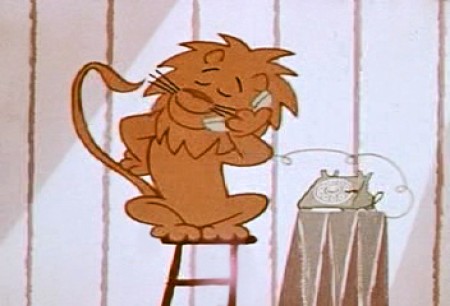 19
19
We get the fable about the lion who calls . . .
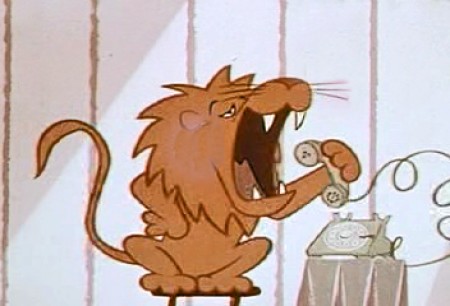 21
21
Though he shouts too loudly into the phone.
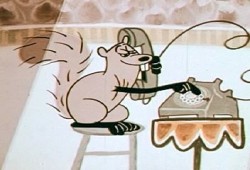 23
23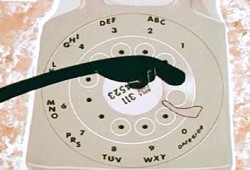 24
24
Then there’s the squirrel who can dial the phone . . .
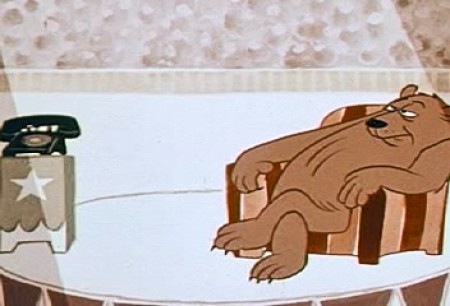 25
25
. . . and the bear who answers the phone too late.
 27
27
Then there’s the elephant who dials the wrong number.
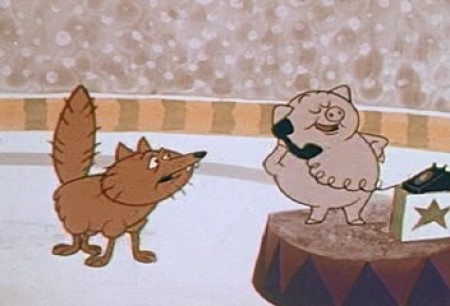 28
28
Finally there’s the pig who won’t get off the phone
so the fox can make an important call.
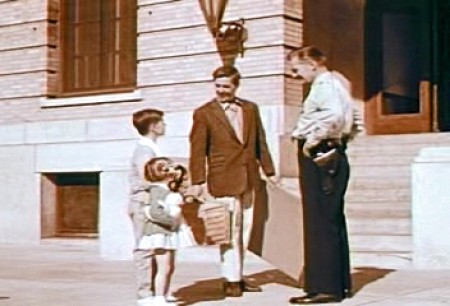 29
29
Next the animator takes the kids to the police station.
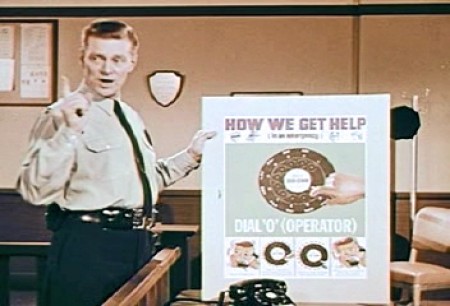 30
30
This way the cop can tell the kids how to make emergency calls.
Title sequences 14 Oct 2009 07:37 am
Paul Julian’s Dementia 13
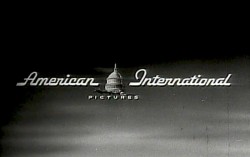 - Dementia 13 was Francis Ford Coppola‘s first real, credited film direction. Done in 1963, it was contrived in a rush to capitalize on the completion of another Roger Corman film, The Young Racers. They were able to use the sets and props from the low-budget film Corman had just finished in Ireland with Coppola as his sound technician.
- Dementia 13 was Francis Ford Coppola‘s first real, credited film direction. Done in 1963, it was contrived in a rush to capitalize on the completion of another Roger Corman film, The Young Racers. They were able to use the sets and props from the low-budget film Corman had just finished in Ireland with Coppola as his sound technician.
When they returned to LA, Coppola and Corman fought, with Corman bringing in another director, Jack Hill, to complete the film as he wanted it adding a few ersatz scenes.
It’s interesting that Paul Julian was able to get in there to do the credits for this film. Presumably Corman brought him in since he did a number of other Corman title sequences. Obviously, the budget was just about nothing (one doubts it even covered the cost of Julian’s paints.) Regardless, the film is notable for Coppola’s name. Julian’s work stood out.
The up front titles are particularly short, as is the credit list at the end.
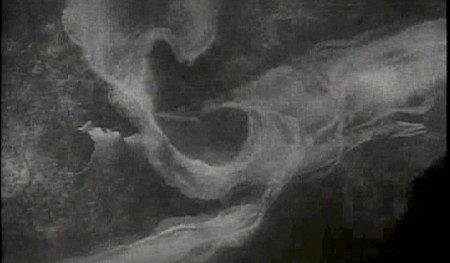 1
1(Click any image to enlarge.)
Hans Bacher on his site, One1more2time3′s Weblog has a couple of posts with recreated Warner Bros backgrounds by Paul Julian.
Books &Commentary &Daily post 13 Oct 2009 07:45 am
Magoo’s Christmas
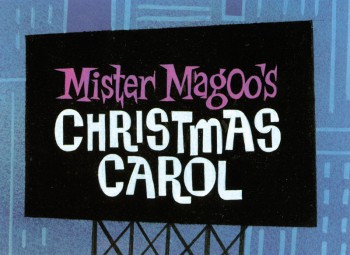
- On Tuesday, Dec 1 The Paley Center in New York will host a screening of Mr. Magoo’s Christmas Carol. After the screening there will be a panel discussion which includes the following guests:
- Darrell Van Citters, Animator and Author of Mister Magoo’s Christmas Carol: The Making ____of the First Animated Christmas Special,
- Judy Levitow, Daughter of Magoo Director Abe Levitow
- Marie Matthews, Voice of “Young Scrooge”
- Moderator: Jack Doulin, of the New York Theatre Workshop.
The program starts at 6pm and general admission is $20. All guests will receive a complimentary DVD of Mister Magoo’s Christmas Carol.
I’ll post this again as we get closer to the date, but you might want to buy tickets in advance for this special program. Hopefully you’ll have the dvd at hand to wash out the taste of the all-Jim Carrey version coming to a theater near you.
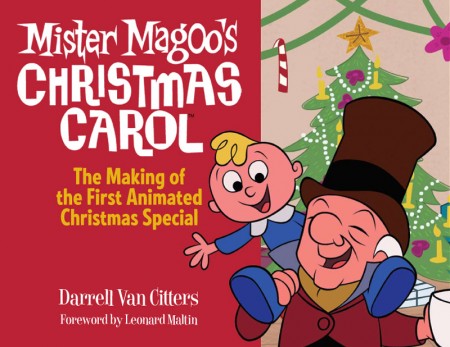 - This announcement gives me the opportunity of recommending, again, Darrel van Citters’ excellent book, Mister Magoo’s Christmas Carol: The Making of the First Animated Christmas Special. Reading this attractive book gave me new insights into the program as well as the production of animation in the relatively early era of tv production. There’s a wealth of behind-the-scenes material about the production from concept to completion.
- This announcement gives me the opportunity of recommending, again, Darrel van Citters’ excellent book, Mister Magoo’s Christmas Carol: The Making of the First Animated Christmas Special. Reading this attractive book gave me new insights into the program as well as the production of animation in the relatively early era of tv production. There’s a wealth of behind-the-scenes material about the production from concept to completion.
Some bits:
- As a fan of Jule Styne‘s work, I find it remarkable the amount of information given about this composer as well as his score for this show. Styne and Bob Merrill were writing FUNNY GIRL for Broadway at the same time, and found themselves bogged down with producton delays. They took the UPA cartoon because they thought it’d be fun and they’d be able to squeeze it in before their Broadway show got up and running again. They also thought they could make a quick buck. Of course, the music gives the show the weight it needs with solid, strong tunes. (There were also a few others asked before Styne was selected.)
Abe Levitow was directing Gay Purr-ee at the exact same time he was doing Magoo’s Christmas Carol. This presented logistic problems which are detailed here in an entertaining read.
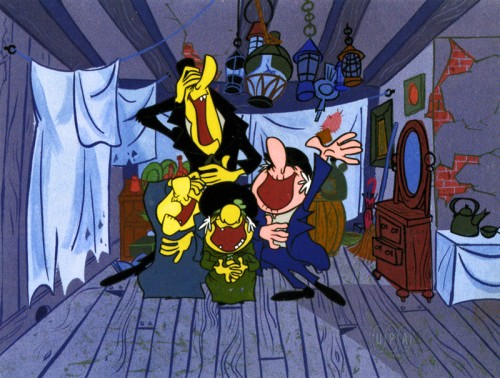
Gerard Baldwin had only two weeks to animate the “Despicables” song.
He completed the sequence, which was one of the highlights of the show, on time.
Shirley Silvey had a limited amount of time away from her work on The Bullwinkle Show. She used it to design the story board for Magoo and help in the early stages of the show’s Layouts.
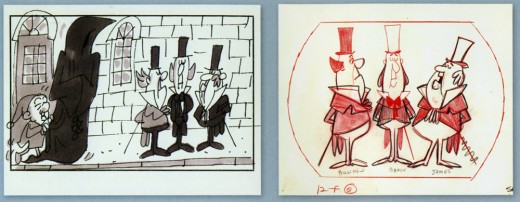
A Shirley Silvey storyboard drawing alongside a matching Layout by Sam Weiss.
It’s a good read with lots of the business side mixed in with the artistry. Darrell Van Citters is a Producer/Director/Animator by day. Consequently, the informed animation reader feels in safe hands throughout the book. He knows what rocks to turn over, and his curiosities in this film are ours. He talks about the things you want to know, and he opens up avenues you didn’t expect to see explored. Van Citters financed this book, himself; he believes in it, and you feel that from the first page. It’s a fine book.
